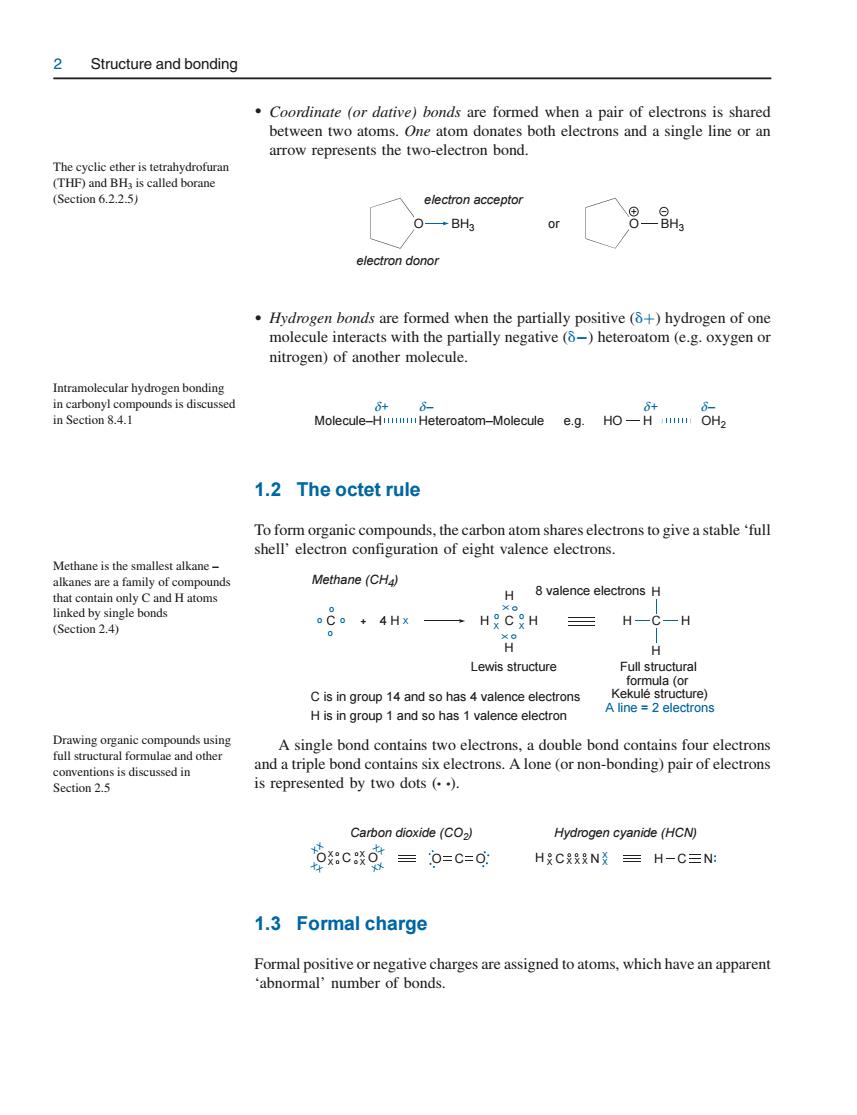正在加载图片...

2 Structure and bonding Coordinate for dative)bonds are formed when a pair of electrons is shared between two atoms.One atom donate s both electrons and a single line or an arrow represents the two-electron bond. THF)a electron acceptor O→BH or 8_8 electron donor .Hydrogen bonds are formed when the partially positive (+)hydrogen of one molecule interacts with the partially negative(-)heteroatom (e.g.oxygen or nitrogen)of another molecule. Molecueeteratom-MolealeHH 1.2 The octet rule To forondthe cabon atom shares electrons to give a stablell shell'elec ration of eight t valence electrons Methane is the smallest alkane- alkanes are a family of Methane(CHa) H8valence electrons H Section 2.4) G。+4 Hx-H2C2H=H-C-H H Lewis structure ral C is in group 14 and so has 4 valence electrons A line =2 electrons H is in group 1 and so has 1 valence electron A single bond contains two electrons,a double bond contains four electrons and a triple bond contains six electrons.A lone(or non-bonding)pair of electrons is represented by two dots () Carbon dioxide (CO) Hydrogen cyanide (HCN) 6:c竖d=0=c=g HCN文三H-C三N 1.3 Formal charge Formal positive or negative charges are assigned to atoms,which have an apparent 'abnormal'number of bonds.Coordinate (or dative) bonds are formed when a pair of electrons is shared between two atoms. One atom donates both electrons and a single line or an arrow represents the two-electron bond. O BH3 or O BH3 electron donor electron acceptor Hydrogen bonds are formed when the partially positive (dþ) hydrogen of one molecule interacts with the partially negative (d) heteroatom (e.g. oxygen or nitrogen) of another molecule. Molecule–H Heteroatom–Molecule e.g. HO H δ+ δ– δ+ δ– OH2 1.2 The octet rule To form organic compounds, the carbon atom shares electrons to give a stable ‘full shell’ electron configuration of eight valence electrons. H CH H H H CH H H o o o o + 4 H Methane (CH4) Lewis structure Full structural formula (or Kekulé structure) A line = 2 electrons 8 valence electrons C is in group 14 and so has 4 valence electrons X X X X C o X o o o H is in group 1 and so has 1 valence electron A single bond contains two electrons, a double bond contains four electrons and a triple bond contains six electrons. A lone (or non-bonding) pair of electrons is represented by two dots ( ). Carbon dioxide (CO2) Hydrogen cyanide (HCN) OCO o oo o H C N oo o o C X XXX O O XX XX XX XX C N X X H X X X X 1.3 Formal charge Formal positive or negative charges are assigned to atoms, which have an apparent ‘abnormal’ number of bonds. The cyclic ether is tetrahydrofuran (THF) and BH3 is called borane (Section 6.2.2.5) Intramolecular hydrogen bonding in carbonyl compounds is discussed in Section 8.4.1 Methane is the smallest alkane – alkanes are a family of compounds that contain only C and H atoms linked by single bonds (Section 2.4) Drawing organic compounds using full structural formulae and other conventions is discussed in Section 2.5 2 Structure and bonding����